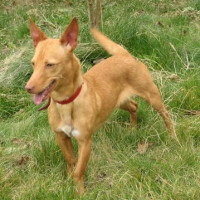 |
Andalusian Podenco |
|
He is not recognized by the F.C.I. |
Origin |
Spain | |
Translation |
Francis Vandersteen |
| The Andalusian dog is a breed of dog native to Spain, particularly Andalusia. They are similar to other Iberian breeds such as Podenco Ibicenco, Podengo Português, Podenco Canario, Maneto and Podenco Orito Español. In the Iberian Peninsula, there are cave paintings depicting dogs that closely resemble these breeds. In fact, it seems that dogs very similar to these have been bred in much of the Mediterranean basin since ancient times, including the Cirneco dell'Etna and the Pharaoh Hound. However, there is also the tradition that Podenacs were introduced to the peninsula by the Phoenicians through their colonies. Several genetic studies carried out in recent years have concluded that, contrary to the widespread belief that the dog is a primitive imported some 3,000 years ago from the Middle East region, these dogs have a close genetic relationship with the rest of the European hunting dogs and are no more "primitive" than most of them. Despite being a native and ancient breed, it wasn't until 1990 that it entered the world of official cynology, with the formation of the Racing Club, which promoted the studies and work necessary for racial characterization, which were carried out by the Animal Ethnology and Identification Unit of the Animal Production Department of the Faculty of Veterinary Medicine of the University of Córdoba, published during the II Symposium of Spanish Canine Breeds in 1992 and recognized by the RSCE as a norm or breed standard in April of that year. same year. It was included in type V Spitz-type dogs and primitive type, section 7 primitive type - hunting dogs. The breed is not recognized by the FCI or any other international cynological association, given the large number of coincidences with the Portuguese dog standard, raising doubts as to whether or not they are really different breeds. As in the Portuguese Podenco, the Podenco Andaluz distinguishes three sizes and three hair types, factors whose combination may come from nine different varieties. Given the size of the varieties are : Large Andalusian Podenco. Podenco andaluz medium. Podenco andaluz chico. If we consider the different hair types, we have the following varieties : Podenco andaluz with sardonic or hard hair. Podenco andaluz de sedeno or long-haired. Podenco andalou with straight or short hair. There's an offshoot of the medium-haired Podenco Andaluz, Maneto, called because of its short, sturdy legs, a phenomenon known in cynology as bassetismo, referring to Bassets. At present, the Maneto is accepted as a racer by the RSCE on a provisional basis. Podencos Andaluces, like other podencos, have a highly developed sense of sight, hearing and smell, which makes them good hunters, especially when it comes to rabbit hunting. In big game raids in central and southern Spain, hounds are at the heart of the rehalas (group of big game dogs, numbering between 20 and 24), which are generally made up of large podencos for harassment and for certain medium-sized specimens such as poaching or searching dogs. In small game, medium and small varieties are used, either individually, in pairs or in récollets (gangs of hunting dogs). One of the most typical characteristics of the large dog is that of the quitaor accompanying the gallops of greyhounds during hare hunting. Their task is, firstly, to get up and go truant from his bed or hide, making him available to the greyhounds, and then finished the whole thing, partly to take the greyhound to take his owner. On Andalusian farms, large animals served as guard dogs and small animals as rodent cleaners. |






 English (United Kingdom)
English (United Kingdom)